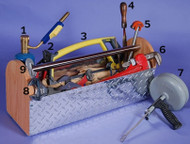Plumbing Basics Knowledge
Sep 26th 2018
Learn About What is What in Plumbing
Learning Objectives:
• The different types of pipe and fittings.
• How to answer your customers’ product-related questions.
• How to help your customer choose the right products.
• How to increase transaction sizes by learning more about add-on sales.
Chapter 1: Pipe and Fittings
Copper Pipe
• Use for carrying water.
• Use compression or sweat connections to join this type of pipe.
• Common sizes of pipe diameter are 3/8”, 1/2” and 3/4”.
• Larger sizes may be used for DWV (drain-waste-vent) applications.
• Some copper pipe can be used as refrigeration tubing. In this case, moisture is removed
and ends sealed for better performance of refrigerants.
• Rigid copper pipe is good for new installation. Soft or flexible copper pipe is good for
repair work since it can bend around obstacles without multiple cuts and joints.
• Type K is heaviest, used in municipal, commercial, residential and underground
installation; Type L is medium weight and is the most commonly used in residential
water lines; Type M is hard and thin.
PVC Pipe
• PVC (polyvinyl chloride) is used for carrying cold water, irrigation, use as conduit and for
DWV (drain-waste-vent) projects.
• Use compression or solvent weld connections to join this type of pipe.
• Available in diameter sizes ranging from 1/2” to 2”.
• Rated by thickness and strength. Schedule 40 is the most common and suited for uses
such as carrying water and for irrigation.
• Schedule 40 with a foam core is suitable for drain and waste applications.
CPVC Pipe
• CPVC (chlorinated polyvinyl chloride), is used for both hot and cold water supply or
chemical distribution systems.
• Use compression or solvent weld connections to join this type of pipe.
• Requires special solvent cement that is different from cement used for other types of
plastic pipes. Most solvents will indicate this on the can.
2
Galvanized Pipe
• Used primarily for carrying water or waste. Do not use for gas or steam applications.
• Use threaded connections to join this type of pipe.
• Use only with similar galvanized pipe fittings, not with black pipe fittings.
• Measured using the I.D. (inside diameter).
• Common water sizes are 3/8”, 1/2”, 3/4” and 1”. Common waste sizes are 1-1/2”, 2”
and 3”.
• Has zinc coating that will prevent rust if it’s not scratched.
• Often sold in pre-threaded standard lengths, or can be custom threaded.
Black Iron Pipe
• Used for carrying steam or gas.
• Used only with black iron pipe fittings, not galvanized fittings.
• Not treated for rust resistance.
• Use threaded connections for joining this pipe.
• Measured using the I.D. (inside diameter).
PEX Pipe
• PEX, which stands for crosslinked polyethylene, is used for carrying hot and cold water.
• Do not weld with solvents. Join with heat fusion, flare, crimp ring or compression fittings.
• Chief advantage is its flexibility and strength. It can make turns around corners
without couplings.
• Excellent chemical resistance to acids and alkalis, but do not use for fuel oil, gasoline or
kerosene systems.
• In a PEX plumbing system, a separate line is run from the main water supply to each
fixture in a setup much like a circuit breaker box.
ABS/DWV Pipe
• Commonly used for DWV (drain-waste-vent) applications or for underground
electrical conduits.
• Use compression or solvent weld connections to join this type of pipe.
• Made from a thermoplastic resin. Lightweight and easier to use than metal pipe.
• Available as either solid wall or cellular core construction.
• ABS stands for Acrylonitrile Butadiene Styrene.
Black Poly Pipe
• Used for carrying low-pressure cold water. Common applications include golf course
sprinklers, underground conduits or to carry corrosive liquids and gases.
• Good chemical and crush resistance.
• Lightweight enough to cut with an ordinary knife or a fine-toothed hacksaw blade.
Vinyl Tubing
• Economical and used in a variety of applications.
• Usually joined with pressure fittings and clamps.


